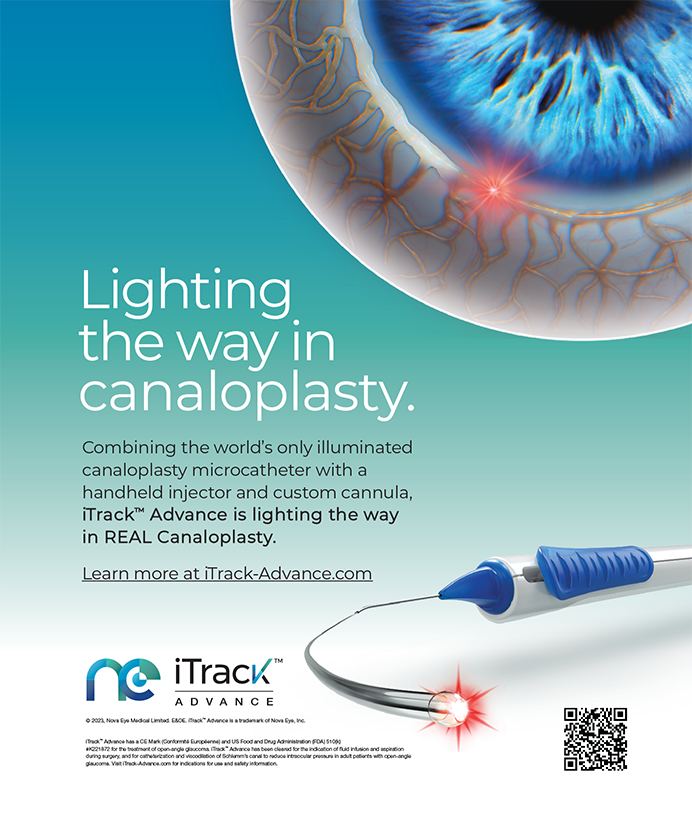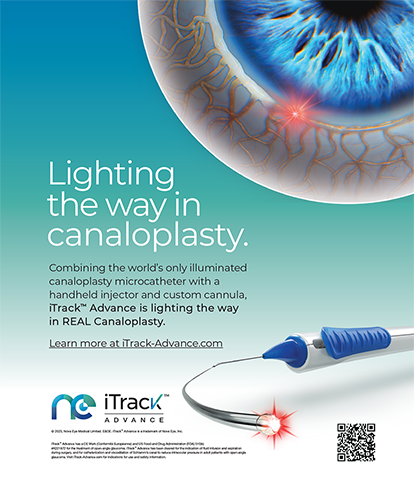A 73-year-old female underwent uncomplicated phacoemulsification and implantation of the AcrySof Restor IOL (Alcon Laboratories, Inc., Fort Worth, TX) in 2006. The patient had a preexisting diagnosis of pseudoexfoliation syndrome. Over time, the IOL has become decentered (sunset syndrome) due to zonular weakness. Although the woman was previously happy with her outcome, she is now symptomatic due to the current position of the IOL. How would you approach this case?
DAVID F. CHANG, MD
Multifocal IOLs are particularly sensitive to tilt or decentration of even slight amounts. This causes higher-order aberrations such as coma and trefoil, which the iTrace (Tracey Technologies, Houston, TX) can identify as coming from the lens. Because pseudoexfoliation is characterized by progressive zonular deficiency over time, there is the risk that new higher-order aberrations may develop later if the lens should tilt. Even in the absence of any surgical zonular laxity, I would recommend using a capsular tension ring in conjunction with a multifocal IOL in these eyes. In this case, I would explant the bag-IOL complex and replace it with an ACIOL. I would not recommend suture fixation of any multifocal IOL due to the likelihood of clinically significant tilt and decentration.
LUTHER L. FRY, MD
If the IOL were entirely in the intact capsular bag, I would lasso the two haptics with 10–0 Prolene sutures (Ethicon, Inc., Somerville, NJ) and fix them to the sclera. If only one haptic were lassoed, the zonules on the opposite side would likely come loose soon, requiring lassoing in the future. I would use iris retractors if the pupil were suboptimal. In my opinion, it is easier to use a 600-µm groove rather than a scleral flap to bury the lasso suture knot.
If the lens were not totally encased in the bag, I would bring the optic up through the pupil and suture the loops to the iris using the technique of Garry Condon, MD,1 and tie the suture with a Siepser sliding knot. If things did not go well during the attempted suturing, I would remove the IOL and replace it with a monofocal ACIOL.
RICHARD J. MACKOOL, MD
I would approach this case in the following manner, regardless of the type of IOL implanted (although this approach excludes plate haptic lenses). I would suture each haptic to the sclera with a double-armed 10–0 Prolene suture and a 27-gauge receptacle needle. The 10–0 Prolene straight needle would enter the eye through a limbal incision opposite the haptic to be sutured, and the receptacle needle would be passed twice through a scleral groove created 1 mm posterior to the limbus adjacent to each haptic. The goal would be to have one end of the suture above and the other below the haptic. One caveat: beware of eyes with large Soemmering’s rings, as passing sutures through them can expose lenticular material that may result in severe postoperative inflammation. An IOL exchange may be a better procedure for these eyes.
ROBERT H. OSHER, MD
For many years, I taught the technique of lassoing the subluxated lens in the Malpositioned IOL course at the AAO. I also published the method of creating “synthetic zonules” when a capsular tension ring is encapsulated within a subluxated bag.2 However, I never thought to combine the techniques until I watched Roger Steinert, MD, reposition a freely floating IOL-bag complex. Although technically challenging, this works well. An alternate approach would be to explant the lens by either cutting or refolding the acrylic material, yet I do not know if this approach would be successful in the presence of a dense Soemmering’s ring. If the patient enjoyed the AcrySof Restor lens and wants to continue with its presbyopia-correcting advantages, a three-piece AcrySof Restor lens could be sutured to either the iris or through the ciliary sulcus. There is also recent literature to support tucking the haptics through the sulcus into scleral tunnels.3 Alternatively, the surgeon could simply exchange the lens for whichever monofocal lens suits his or her and the patient’s preference and place it wherever he or she prefers inside the eye.
MARK PACKER, MD
I recommend suture fixation using Hoffman scleral pockets dissected posteriorly from the clear cornea.4 The basic technique was described by Oshika and memorialized by Gimbel et al in a useful review article.5 In brief, a 27-gauge nesting needle is passed through the superior conjunctiva and sclera in the region of greatest subluxation. The needle traverses the previously constructed pocket and enters the eye at the ciliary sulcus. The tip is maintained posterior to the fibrotic capsule as a 10–0 Prolene suture on a CIF- 4 needle (Ethicon, Inc.) is introduced through a paracentesis, passed through the capsule posterior to a haptic, and passed into the nesting needle (which has been used for countertraction against the force of the CIF-4 needle). The suture is retrieved from the pocket with a Sinskey hook. The second arm of the suture is passed through the same paracentesis, but anterior to the haptic; withdrawn through the pocket with a needle; and retrieved with a hook in the same way as the first arm. Finally, the suture is tied inside the pocket in a 3-1-1 surgeon’s knot. The procedure may be repeated for the inferior haptic if the surgeon feels it is necessary.
Section editor John F. Doane, MD, is in private practice with Discover Vision Centers in Kansas City, Missouri, and he is a clinical assistant professor with the Department of Ophthalmology, Kansas University Medical Center in Kansas City, Kansas. Dr. Doane may be reached at (816) 478-1230; jdoane@discovervision.com.
David F. Chang, MD, is a clinical professor at the University of California, San Francisco. Dr. Chang donates his consulting fees from Abbott Medical Optics Inc. and Alcon Laboratories, Inc., to Project Vision and the Himalayan Cataract Project. He acknowledged no financial interest in the products or other companies he mentioned. Dr. Chang may be reached at (650) 948-9123; dceye@earthlink.net.
Luther L. Fry, MD, is a clinical assistant professor of ophthalmology at the University of Kansas Medical Center in Kansas City. He acknowledged no financial interest in the products or companies he mentioned. Dr. Fry may be reached at (620) 275-6302; lufry@fryeye.com.
Richard J. Mackool, MD, is the director of the Mackool Eye Institute and Laser Center in Astoria, New York. He is consultant to Alcon Laboratories, Inc. Dr. Mackool may be reached at (718) 728-3400, ext. 256; mackooleye@aol.com.
Robert H. Osher, MD, is a professor of ophthalmology at the University of Cincinnati, medical director emeritus of the Cincinnati Eye Institute, and editor of the Video Journal of Cataract and Refractive Surgery. He is a consultant to Alcon Laboratories, Inc., but has no financial interest in the products he mentioned. Dr. Osher may be reached at (513) 984-5133; rhosher@cincinnatieye.com.
Mark Packer, MD, is a clinical associate professor at the Casey Eye Institute, Department of Ophthalmology, Oregon Health and Science University, and he is in private practice with Drs. Fine, Hoffman & Packer, LLC. He acknowledged no financial interest in the products or companies he mentioned. Dr. Packer may be reached at (541) 687-2110; mpacker@finemd.com.
- Condon GP,Ahmed I,Masket S, et al.Peripheral iris fixation of foldable acrylic posterior chamber IOLs:efficacy and complications.Ophthalmology.2007;114:1311-1318.
- Osher RH.New approach:synthetic zonules.Video Journal of Cataract and Refractive Surgery.1997;13(1).
- Scharioth GB, Prasad S, et al.Intermediate results of sutureless intrascleral posterior chamber intraocular lens fixation.J Cataract Refract Surg.2010;36(2):254-259.
- Hoffman RS, Fine IH, Packer M.Scleral fixation without conjunctival dissection.J Cataract Refract Surg. 2006;32(11):1907-1912.
- Gimbel HV, Condon GP,Kohnen T, et al.Late in-the-bag intraocular lens dislocation:incidence, prevention, and management.J Cataract Refract Surg.2005;31(11):2193-204.


